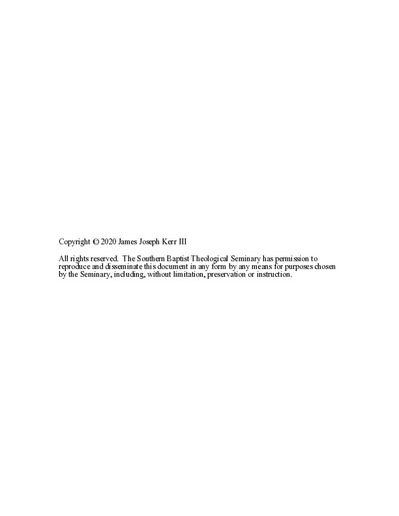| dc.contributor.advisor | Klaassen, John M. | |
| dc.contributor.author | Kerr, James J. | |
| dc.date.accessioned | 2020-05-13T19:13:39Z | |
| dc.date.available | 2020-05-13T19:13:39Z | |
| dc.date.issued | 2020-05 | |
| dc.identifier.uri | https://hdl.handle.net/10392/6081 | |
| dc.description | D.Miss., The Southern Baptist Theological Seminary, 2020 | en_US |
| dc.description.abstract | Chapter 1 introduces the question of using honor and shame by showing how
honor and shame have helped to shape missiology. The problem of the role and use of
honor and shame Ecuadorian culture frames the remainder of the dissertation research.
The chapter concludes by survey recent scholarship concerning honor and shame, as well
as defining key terms, and stating research methodology.
Chapter 2 looks at the aspect of honor and shame as it relates to the aspect of
covenant within the Bible. Each section on the covenants highlights the various aspects of
honor and shame. The relational changes for those in the covenant and those who are not
will further show how honor and shame functions. This section concludes by highlighting
contextualization concerns when focusing on honor and shame within covenants.
Chapter 3 surveys honor and shame as a cultural identifying mark. Typically,
there are three types of cultural worldviews, guilt and innocence, power and fear, and
honor and shame. Each culture has each three albeit each with a different emphasis. Since
the idea of honor and shame is present to some degree within all cultures, it is necessary
to take this into account when engaging different cultures.
Chapter 4 briefly traces the honor and shame roots through the history of
conquest. Latin American culture began with a seven hundred years’ war over the Iberian
Peninsula. There are language and cultural overlaps between the Arab and Latin
American culture. During the end of the war in the Iberian Peninsula, there was a war up
the Andes mountains by the Incan Empire. Their conquest and religious history helped
pave the way for the conquistadors to take over. After the Spanish began to rule, there
were rules set in place which helped to keep things the status quo until Ecuador changed
the constitution in 1998 formerly recognizing Indigenous people.
Chapter 5 synthesizes much of the information by making practical
applications for missionaries. Since honor and shame is a useful paradigm to use when
engaging cultures, it also presents various dangers to an incorrect application of
honor/shame. The conclusion shows both the benefits and dangers of honor and shame
while engaging Ecuadorians. | en_US |
| dc.subject.lcsh | Honor in the Bible | en-us |
| dc.subject.lcsh | Honor--Religious aspects--Christianity | en-us |
| dc.subject.lcsh | Shame in the Bible | en-us |
| dc.subject.lcsh | Shame--Religious aspects--Christianity | en-us |
| dc.subject.lcsh | Missions--Ecuador | en-us |
| dc.subject.lcsh | Ecuador--Civilization | en-us |
| dc.title | Honor and Shame in Ecuador | en_US |
| dc.type | Electronic project | en_US |
| dc.type | Text | |
| dc.contributor.committee | Bosch, David A. | |
| dc.type.qualificationname | D.Miss. | en_US |
| dc.publisher.institution | Southern Baptist Theological Seminary | en_US |
| dc.publisher.department | School of Missions and Evangelism | |

